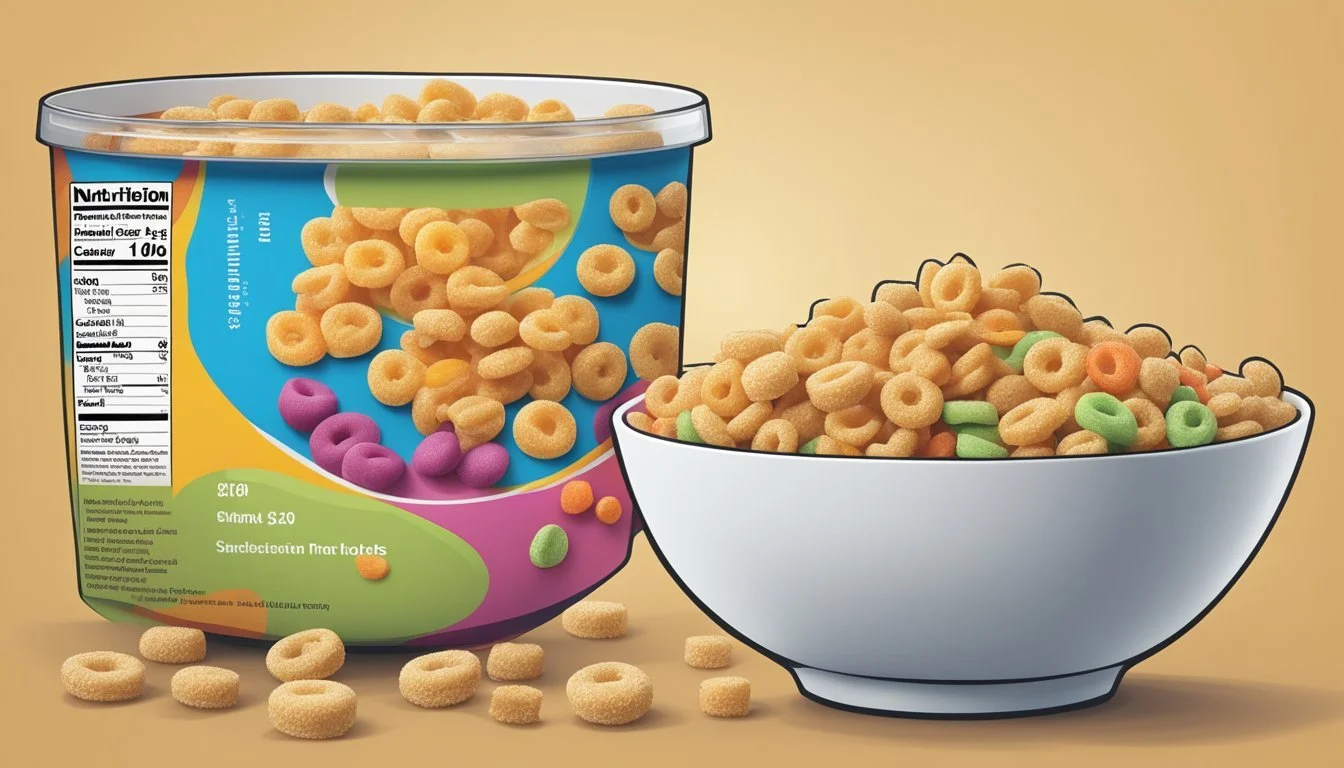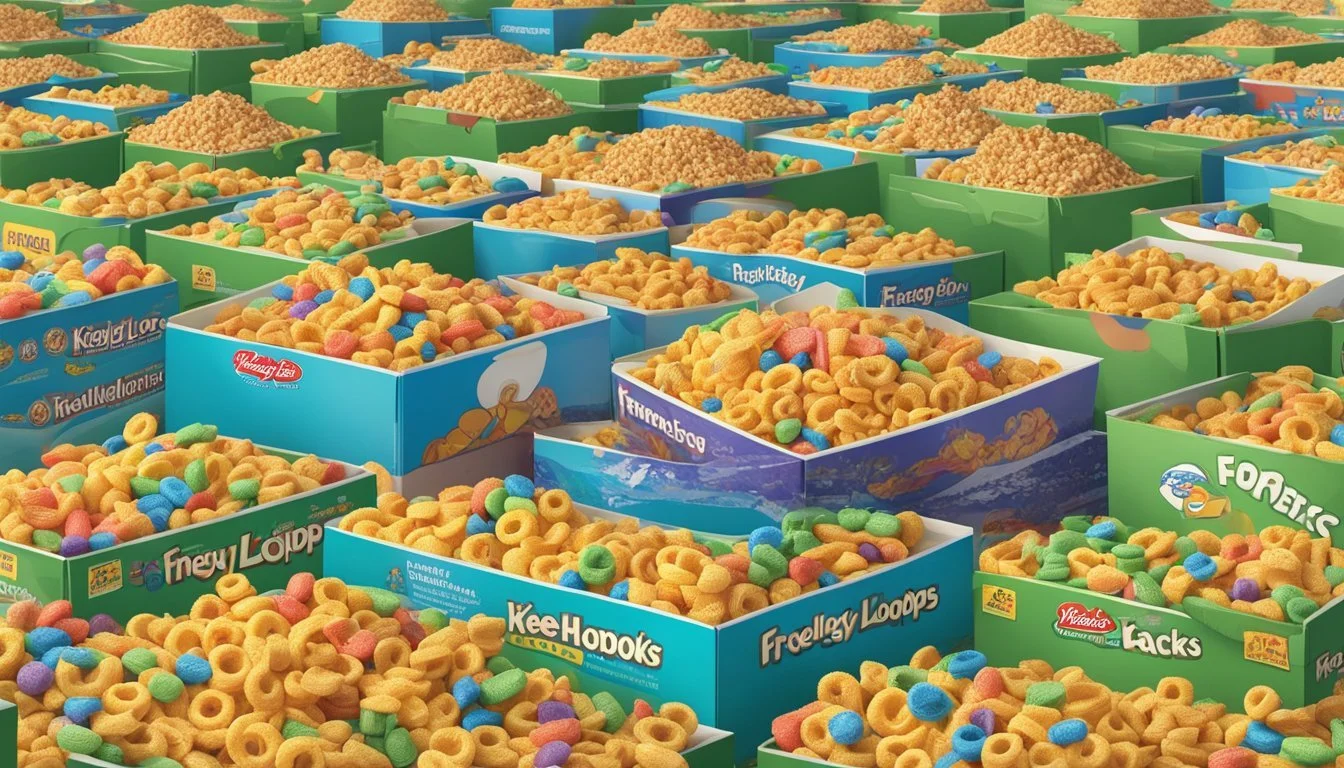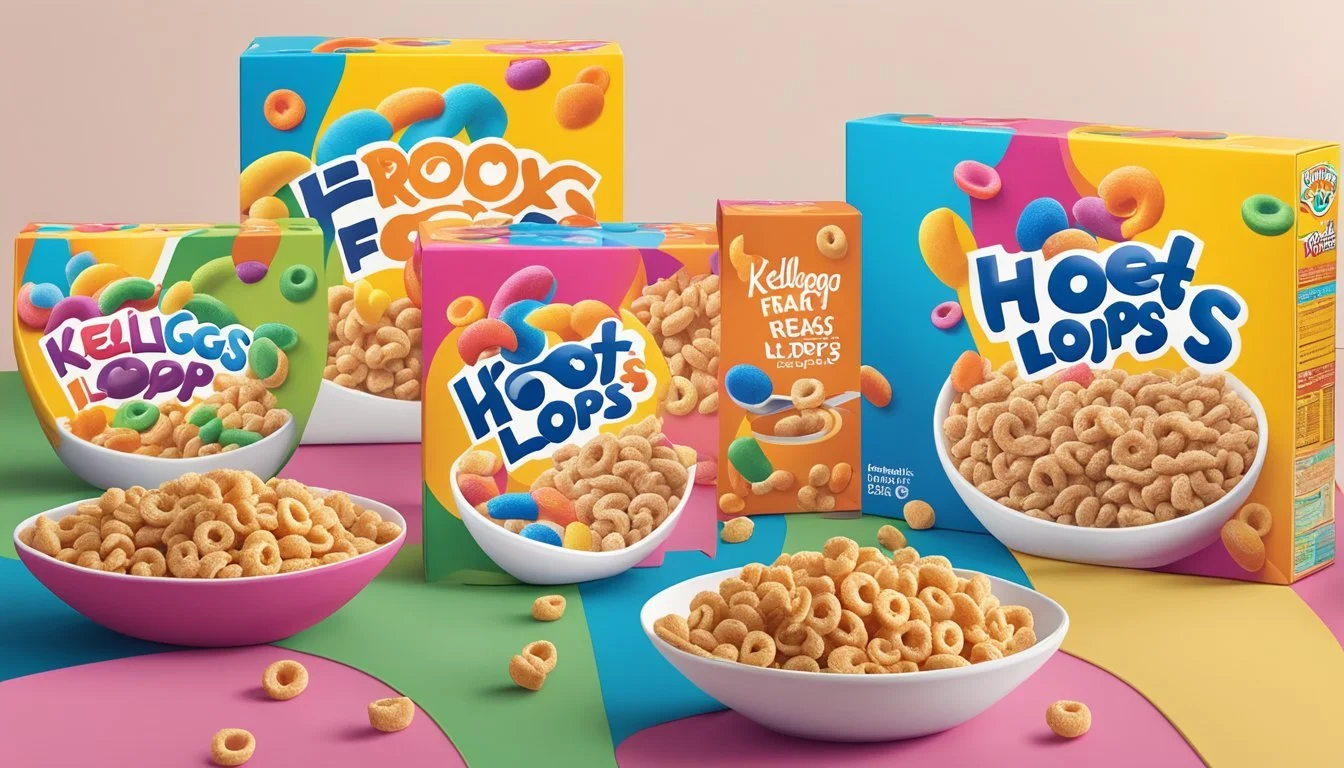Honey Smacks vs Kellogg's Froot Loops
A Nutritional Comparison
This Article is Part of Our Breakfast Cereal Guide with Details on Honey Smacks Nutrition and Kellogg's Froot Loops Nutrition
Choosing the right breakfast cereal can be challenging with so many options on the supermarket shelves. For those debating between Honey Smacks and Kellogg's Froot Loops, the decision may ultimately come down to nutritional value and personal preference. Both cereals, produced by Kellogg's, offer unique flavors that cater to different tastes, but how do they stack up against each other in terms of health benefits?
Kellogg's Froot Loops, known for their vibrant colors and fruity flavor, have been a family favorite for years. On the other hand, Honey Smacks, with their sweet, honey-coated puffs, appeal to those with a penchant for a sweeter breakfast option. When comparing these cereals, it's essential to consider the sugar content, vitamins, and minerals they provide. For instance, Honey Smacks is often noted for its high sugar content, whereas Froot Loops might be favored for its slightly lower sugar and higher vitamin fortifications.
Consumers looking to make a healthier choice might lean towards one over the other based on these nutritional aspects. Both cereals serve as a quick, convenient breakfast option, but understanding their make-up can help in making an informed decision.
Historical Background
Honey Smacks and Froot Loops, two of Kellogg's iconic cereals, have distinct origins and development histories. Here, we delve into their beginnings and how they have evolved.
Origins of Honey Smacks
Introduced in 1953, Honey Smacks were originally named "Sugar Smacks." Despite multiple name changes, the core recipe, known for its high sugar content, remained relatively unchanged.
In the 1980s, the brand aimed to soften its sugary image by renaming the cereal to "Honey Smacks," even though the sugar level stayed the same.
Marketed towards children, the initial packaging and advertising capitalized on the sweet taste and fun, memorable mascot.
Over time, despite its high sugar content, Honey Smacks became a beloved breakfast option, with Kellogg's continually adjusting its image to stay relevant in an ever-evolving cereal market.
Development of Froot Loops
Froot Loops was launched by Kellogg's in 1963, crafted to replace an unsuccessful cereal known as OKs. OKs consisted of pieces shaped like the letters "O" and "K" and were an attempt to replicate the success of Cheerios by General Mills.
The introduction of Froot Loops marked a significant shift for Kellogg's.
The delightful, colorful loops along with the charming Toucan Sam mascot quickly captivated the younger audience.
Initially marketed as a fun, fruity cereal, Froot Loops' distinctive flavor comes from a blend of various fruit flavors, which has remained a staple.
Froot Loops has managed to stay relevant through various marketing strategies and product innovations, cementing its place in cereal history.
Evolution in the Cereal Industry
Both Honey Smacks and Froot Loops have witnessed considerable changes in the cereal industry, driven by consumer preferences and regulatory pressures.
The Food and Drug Administration (FDA) and other regulatory bodies have influenced these cereals' formulations, especially in terms of sugar content and nutritional value.
During the 1980s and 1990s, there was a notable shift towards marketing cereals as healthier options. Kellogg's responded by adjusting recipes and promoting more balanced nutrition.
Though the fundamentals of Honey Smacks and Froot Loops stayed the same, their marketing and positioning adapted to new health trends and consumer demands.
This adaptability has kept both cereals popular across different generations.
Nutritional Comparison
When comparing Honey Smacks and Froot Loops, key nutritional differences emerge. These differences include caloric content, sugar and fat levels, and overall nutritional value concerning vitamins and minerals.
Caloric Content and Serving Sizes
Froot Loops and Honey Smacks have different caloric contents per serving.
Froot Loops: A typical serving size is 1 cup (about 29 grams), providing approximately 110 calories.
Honey Smacks: A serving size is 3/4 cup (about 30 grams), offering around 120 calories.
Both cereals aim to provide a moderate calorie count, but it's important to factor in serving sizes to understand the true caloric intake. Smaller portions may seem less calorie-dense, but consuming multiple servings can quickly add up.
Sugar and Fat Content
Sugar content is a significant concern for both cereals.
Froot Loops: Contains about 12 grams of sugar per serving.
Honey Smacks: Notably higher, with around 15 grams of sugar per serving.
Regarding fat content:
Froot Loops: Approximately 1 gram of fat per serving, with no saturated fat reported.
Honey Smacks: Less than 1 gram of total fat, also free from saturated fats.
Both cereals avoid trans fats and are low in overall fat content, but Honey Smacks has a higher sugar concentration, compelling consumers to consider their overall daily sugar intake.
Overall Nutritional Value
Both cereals offer a range of vitamins and minerals, but their nutrient profiles differ.
Froot Loops: Higher in Iron, Vitamin C, Zinc, and Fiber. Iron coverage is substantially high, meeting 175% of the daily recommended value per serving.
Honey Smacks: Richer in Manganese, Selenium, Phosphorus, Vitamin B12, and Copper. This makes it valuable for micronutrients not as prevalent in Froot Loops.
Additional nutrients include:
Froot Loops: Provides higher levels of fibers, aiding digestion.
Honey Smacks: Offers Vitamin B6, contributing to better metabolic functioning.
Both cereals come with notable amounts of vitamins and minerals, making them nutritious options, but each has its unique strengths.
Focusing on one's specific nutritional needs—whether it's more iron and fiber from Froot Loops or micronutrients from Honey Smacks—will help make a more informed cereal choice.
Health and Diet Considerations
When comparing Honey Smacks and Kellogg's Froot Loops, several health and dietary dimensions come to the fore such as nutritional content, dietary restrictions, and the importance of whole grains and fiber. Understanding these factors can help consumers make informed decisions about their breakfast choices.
Recommendations for a Balanced Breakfast
A balanced breakfast should ideally contain a mix of protein, healthy fats, and carbohydrates. Both Honey Smacks and Froot Loops contain 2 grams of protein per serving. However, Froot Loops include 12g of added sugars, making them less suitable for a low-sugar diet.
Controlling sugar intake is vital for maintaining stable energy levels and avoiding sugar crashes. Including fruits, nuts, and yogurt alongside these cereals can bolster their nutritional profile, adding more fiber and healthy fats.
Dietary Restrictions and Allergens
Froot Loops and Honey Smacks are both made by Kellogg's, and they share some common ingredients and potential allergens. Both cereals contain gluten, posing a problem for those with celiac disease or gluten intolerance. Additionally, artificial colors in Froot Loops can cause hyperactivity in some children.
For those following a low-sodium diet, Honey Smacks may be a better option with 70 mg of sodium per serving compared to Froot Loops' 125 mg. Checking ingredient lists for potential allergens like nuts, soy, or dairy is essential.
The Role of Whole Grains and Fiber
Fiber plays a crucial role in maintaining digestive health and keeping you full longer. Froot Loops are richer in dietary fiber compared to Honey Smacks. Choosing cereals with higher fiber content can contribute to a lower glycemic index, beneficial for those managing diabetes or following a low-glycemic index diet.
Whole grains are another critical component of a healthy diet. They are packed with vitamins, minerals, and other nutrients. Adding more whole foods like oats, barley, or quinoa to the diet can further enhance these cereals' nutritional value.
Incorporating these considerations can lead to a more balanced and health-conscious breakfast choice, paving the way for better overall dietary habits.
Brand Marketing and Consumer Perception
Kellogg's employs various marketing strategies and designs tailored packaging to enhance brand identity and consumer appeal for both Honey Smacks and Froot Loops. Public reception of these cereals influences demand, shaped by advertising, labeling, and health considerations.
Advertising Tactics and Brand Identity
Kellogg's utilizes colorful and engaging advertising for Froot Loops to attract children, incorporating the playful character Toucan Sam.
Honey Smacks advertising focuses more on taste and nostalgia, targeting an older demographic.
Both brands use commercials, social media, and in-store promotions to reinforce their identities.
Packaging and Labeling
Froot Loops and Honey Smacks feature vibrant, eye-catching packaging to grab consumer attention.
Froot Loops uses bright colors and cartoon imagery to attract younger audiences.
Honey Smacks emphasizes nostalgic elements with classic designs.
Labeling plays a crucial role, as both cereals have adapted to regulations by including nutritional information and warning labels, especially in markets like Mexico.
Public Reception and Demand
Public perception of these cereals influences demand significantly.
Froot Loops garners attention for its colorful presentation but faces scrutiny over its sugar content.
Honey Smacks, while also popular, is often viewed through a nostalgic lens, appealing to those who enjoyed it as children.
Both cereals face challenges from health-conscious consumers and organizations like the Environmental Working Group, which rates them based on sugar content and nutritional value. Demand fluctuates accordingly.
Comparison in Taste and Texture
When evaluating the taste and texture of Honey Smacks and Kellogg's Froot Loops, distinct differences emerge. These variations are central to consumer preferences and sensory experiences.
Flavor Profiles
Honey Smacks offers a sweet, honey-infused flavor that appeals to those who favor a natural sweetness. This cereal is known for its light, crisp texture that enhances the honey taste.
Kellogg's Froot Loops, on the other hand, features a blend of fruity flavors, notably citrus and berry, with each color loop contributing to the overall taste. The crunchiness of Froot Loops makes for a satisfying texture contrast that many enjoy.
Consumer Preferences
Consumers often choose Honey Smacks because of its simple, sweet taste that isn't overpowering. The cereal’s light texture also makes it easy to eat without becoming mushy quickly.
Kellogg's Froot Loops attracts those who enjoy a vibrant, fruity flavor variety. Its colorful appearance and robust crunchiness also make it popular, especially among children, who appreciate the different flavors perceived in each bite.
Preferences thus hinge on the desire for either the distinctive honey flavor of Honey Smacks or the fruity mix and crunch of Froot Loops.
Regulatory and Safety Considerations
Kellogg’s Honey Smacks and Froot Loops have faced scrutiny from health agencies due to safety concerns and regulatory actions. Key aspects include adherence to FDA guidelines and specific recalls issued for contamination and quality issues.
FDA Standards and Guidelines
The FDA sets strict standards to regulate the safety and quality of breakfast cereals like Honey Smacks and Froot Loops. Manufacturers must ensure that cereals meet these standards, which include permissible levels of contaminants, nutritional labeling accuracy, and the proper use of additives.
Ingredients used must comply with FDA guidelines. Regular inspections and testing are performed to ensure compliance. Failure to meet these standards can result in penalties and mandatory corrective actions.
Recalls and Safety Alerts
Kellogg’s has issued voluntary recalls for both Honey Smacks and Froot Loops under consultation with the FDA. A notable recall occurred due to an uncharacteristic off-flavor and smell from the liner in the packaging, affecting several products, including Honey Smacks and Froot Loops.
Customers reported nausea, prompting Kellogg's to recall 28 million boxes. The Environmental Working Group (EWG) followed up by requesting detailed information, highlighting the importance of vigilance in food safety processes.
Environmental and Ethical Impacts
Analyzing the environmental and ethical impacts of Honey Smacks and Kellogg's Froot Loops requires looking closely at Kellogg's sustainability and corporate responsibility initiatives, as well as the Environmental Working Group's evaluations.
Sustainability Practices
Kellogg's has committed to several sustainability initiatives to reduce the environmental footprint of its cereals, including Honey Smacks and Froot Loops.
They have pledged to reduce greenhouse gas emissions by supporting sustainable agriculture and improved energy efficiency across operations.
In England, Kellogg's collaborates with local farmers to implement sustainable practices, such as reducing water usage and promoting biodiversity.
Packaging also plays a significant role. Kellogg's aims to make 100% of their packaging reusable, recyclable, or compostable by 2025. The Environmental Working Group often assesses corporate claims and notes Kellogg's progress in sustainable packaging.
Corporate Social Responsibility
Corporate social responsibility (CSR) at Kellogg's extends to ethical sourcing, community engagement, and employee welfare.
Kellogg's CEO leads efforts to ensure that ethical practices are embedded in all supply chain activities, from sourcing raw materials to production.
For instance, the company is committed to responsible sourcing of palm oil and cocoa, crucial for reducing deforestation and supporting fair labor practices. They have also joined various global initiatives to promote human rights and sustainable development.
Furthermore, Kellogg's invests in local communities through programs aimed at reducing hunger and promoting education. This includes partnerships with schools and NGOs to support breakfast programs for children.
The Environmental Working Group recognizes these efforts, highlighting Kellogg's ongoing work to balance corporate growth with social and environmental responsibility.
Consumer Resources and Additional Information
Consumers looking to compare Kellogg's Honey Smacks and Kellogg's Froot Loops can find essential details ranging from purchasing options to expert dietary advice. This section offers practical resources for making informed choices.
Where to Buy and Pricing Comparison
Both Kellogg's Honey Smacks and Kellogg's Froot Loops are widely available at major supermarkets such as Walmart, Target, and Kroger. For those preferring organic and specialty stores, Whole Foods may also carry these cereals depending on the location.
Prices can vary by retailer and region, but generally:
Kellogg's Honey Smacks: $3.50 - $4.50 for a 15.3 oz box
Kellogg's Froot Loops: $2.99 - $3.99 for a 10.1 oz box
Online shopping is another option, with platforms like Amazon and Instacart offering competitive prices and delivery options. Checking local store flyers and online deals can yield savings.
Nutritional Insights and Expert Advice
When it comes to nutritional value, both cereals have unique profiles. Kellogg's Honey Smacks typically contains about 15g of sugar per serving, while Kellogg's Froot Loops has around 12g of sugar per serving.
Froot Loops is often noted for its vibrant colors, which come from artificial dyes. Honey Smacks is known for its distinct honey flavor but has been criticized for high sugar content.
Nutrition experts suggest checking updated labels for the latest ingredient and serving size information. Reading health reviews on platforms like Fooducate can help consumers understand the benefits and drawbacks of each cereal. For those prioritizing healthy eating, considering whole grains and lower sugar options might be advisable.
More on Honey Smacks
More on Kellogg's Froot Loops
Cinnamon Toast Crunch vs Kellogg's Froot Loops: Which is better?
French Toast Crunch vs Kellogg's Froot Loops: Which is better?
Honey Nut Cheerios vs Kellogg's Froot Loops: Which is better?
Kellogg's Apple Jacks vs Kellogg's Froot Loops: Which is better?
Kellogg's Froot Loops vs Post GrapevsNut Flakes: Which is better?
Kellogg's Froot Loops vs Post Raisin Bran Cereal: Which is better?







